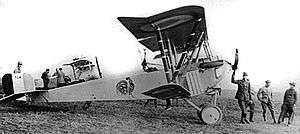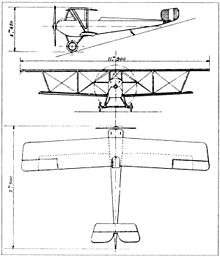Nieuport 14
| Nieuport 14 | |
|---|---|
 | |
| Role | Reconnaissance aircraft |
| National origin | France |
| Manufacturer | Nieuport |
| First flight | September 1915 |
| Introduction | 1916 |
| Primary user | Aéronautique Militaire |
| Number built | 100 |
|
| |

The Nieuport 14 was a military reconnaissance sesquiplane produced in France during the First World War. When the French Army deployed it in 1916, they found its performance inferior to what was called for in the original specification, and the type was quickly withdrawn from front-line service.[1][2]
Developed in response to an order by the Aéronautique Militaire in summer 1915, it was to have been a two-seat reconnaissance machine capable of making a flight of 180 km (97 nmi; 110 mi) and back while carrying a load of bombs.[3] Nieuport's design was based on the Nieuport 12 reconnaissance aircraft, but had its fuselage stretched to balance out the single nose mounted Hispano-Suiza V-8 engine and its wingspan increased by the addition of an additional bay.[3][4]
Deliveries to three reconnaissance squadrons commenced in late 1916, replacing obsolete Voisin types. However, the Nieuport 14's sluggish performance became immediately apparent and these squadrons were re-equipped with Nieuport 17s only eighteen days later and re-deployed as fighter squadrons.[2] Production of the Nieuport 14 was halted,[3] and remaining machines were relegated to training duties once improvements had been made to their side-mounted radiators.[4] These were followed into service by a dedicated trainer variant, the Nieuport 14 École with dual controls, a nosewheel to guard against nose-over accidents, and a rotary engine of lower power replacing the V-8 of the original design.[4] It is possible that these airframes had been left over from the original abortive production attempt.[4] When further refined, the trainer version became known as the Nieuport 82, nicknamed Grosse Julie ("Big Julie"),[4] and aside from service in France, examples were exported to Brazil and Japan. Further development would lead to the Nieuport 15.
Three Nieuport 14s were modified for test purposes; one with cut-outs in its wings to improve visibility and fitted with a 180 hp (130 kW) Lorraine-Dietrich 8A engine, another with a 150 hp (110 kW) version of the Hispano-Suiza engine originally fitted, and a third with a 220 hp (160 kW) Hispano-Suiza engine and a crescent-shaped wing.[4]
Variants
- Nieuport 14 A.2 - service designation of reconnaissance aircraft
- Nieuport 14 E.2 - service designation of trainer
- Nieuport 82 E.2 - dedicated trainer version
Operators
Specifications

Data from Nieuport Aircraft of World War One[4]
General characteristics
- Crew: Two, pilot and observer
- Length: 7.90 m (25 ft 11 in)
- Wingspan: 11.90 m (39 ft 1 in)
- Height: 3.20 m (10 ft 6 in)
- Wing area: 30.0 m2 (323 ft2)
- Empty weight: 620 kg (1,400 lb)
- Gross weight: 970 kg (2,100 lb)
- Powerplant: 1 × Hispano-Suiza 8 liquid-cooled V-8 piston engine, 100 kW (140 hp)
Performance
- Maximum speed: 155 km/h (97 mph)
- Endurance: 4 hours
Armament
- 1 × trainable 0.303 in (7.7 mm) Lewis gun in rear cockpit for observer
- small load of bombs
References
- ↑ Taylor, Michael J. H. (1989). Jane's Encyclopedia of Aviation. London: Studio Editions. p. 697.
- 1 2 The Illustrated Encyclopedia of Aircraft. London: Orbis Publishing. p. 2598.
- 1 2 3 Hartmann, Gérard (2006). "Les Nieuport de la guerre" (PDF). La Coupe Schneider et hydravions anciens/Dossiers historiques hydravions et moteurs. p. 12. Retrieved 2008-11-07.
- 1 2 3 4 5 6 7 Sanger, Ray (2002). Nieuport Aircraft of World War One. Ramsbury: Crowood. pp. 41–44, 71.
| Wikimedia Commons has media related to Nieuport. |